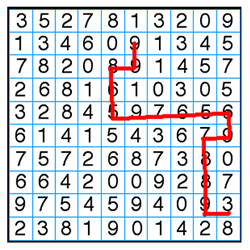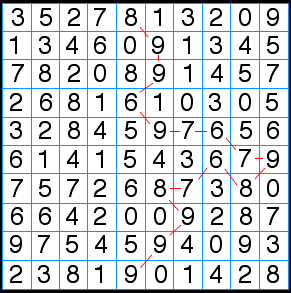Or search by topic
Number and algebra
Geometry and measure
Probability and statistics
Working mathematically
Advanced mathematics
For younger learners
A Numbered Route



- Problem
- Getting Started
- Student Solutions
- Teachers' Resources
The solution you get for this problem depends on whether you start and end at the edge of the grid or not. Georgina from Ruyton Girls School, Melbourne, Australia found a route with a total of 124 which didn't end at the edge. She sent in this diagram to show it:

When not allowed to use diagonals, Georgina found a path with a total of 114:

When we could use diagonals we found two routes that added up to 125 and this was the highest amount that we could find. When we weren't allowed to go diagonally the highest route that we found was 115. First we highlighted the numbers 8 and 9 to show us where to concentrate our route. Some of us highlighted the numbers 0-3 so that we knew the areas to avoid. Next we began a route trying to include as many high numbers as possible, whilst trying to bypass the lower numbers. Once we had set our route we added up our numbers - we checked these a maximum of four times to ensure our answers were correct. We also found it important to check that we had only used 16 numbers (We thought we had a really high answer and then realised that we had used 18 squares).
A very clearly explained method. Unfortunately we were not able to access the picture that they sent of their route. Perhaps you can find the path they are describing?
Pupils (and staff!) at Gayhurst School in Gerrards Cross have found a highest total of 126, in two different ways. Here are their routes:


Well done to all who contributed!
You may also like
Worms
Place this "worm" on the 100 square and find the total of the four squares it covers. Keeping its head in the same place, what other totals can you make?
Which Scripts?
There are six numbers written in five different scripts. Can you sort out which is which?
Highest and Lowest
Put operations signs between the numbers 3 4 5 6 to make the highest possible number and lowest possible number.

